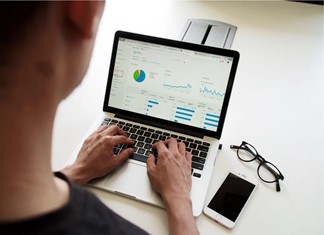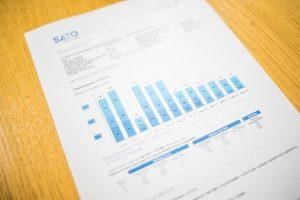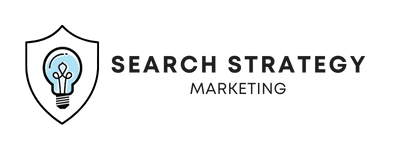
Marketers often say that they dream of a world where they wouldn’t have to worry about data aggregation. However, if you’re new to the game, you may not even know what it is. And if that’s the case, this is the article for you. Today, we’ll answer the question of what data aggregation is in marketing, and we’ll talk about how you can handle it.
In essence, data aggregation is the foundation of marketing analysis. It affects how quickly or even if you can get useful insights from your marketing data. Without it, you won’t be able to make any predictions, and you’ll find yourself working a lot harder just to finish up your basic reports. So, it makes your life easier.
We know it’s a lot to grasp if you only want to generate more leads from your website, but you’ll need it to get the most out of your advertising efforts. So, let’s dive into it and see what you need to learn. We’ll start with the basics.
What is data aggregation?
Data aggregation is the process of joining data from multiple sources in one place so you can analyze it and create reports. It sounds simple enough, but it can be very challenging for marketers in practice, thanks to the number of channels, media platforms, and analytics tools they use.
On average, a multi-channel campaign will run on at least seven different channels. So, you’ll have to work with a lot of data, and it all comes from different sources. To make it easy to read and analyze, you’ll have to use data aggregation. And here, you can go for either a manual or automated version of it.

Data aggregation in marketing is compiling data and organizing it to get insights.
Manual data aggregation
As the name suggests, manual data aggregation is when you manually download campaign data from ad networks and media platforms. When you click that download button, you get a spreadsheet that you can edit, take the data, and combine with other sources. A few years back, this was the only way to do it, and believe us — it wasn’t fun.
Of course, if you’re running a small business and you don’t use more than a couple of media platforms, it’s not that bad. You’ll spend a few hours on it every month or so, and the chances are that’s something you can deal with. At the end of the day, your business can gain much from data aggregation, so it makes sense to do it, even manually.
However, when you’re an agency with more than a couple of dozen of clients, things are a bit different. Each of your clients will use at least five channels in their campaigns, and they’ll want to see weekly reports. Or let’s say that you’re a marketer for a company that has shops all around the country, and they want to see their reports broken out by ZIP code.
It doesn’t make sense to do that much work by hand. Even if you pay someone to do just that, they’ll quickly get tired of it. And on top of that, there’s a chance of human error, so it’s just not worth it. You won’t have any time to get into the insights, and you won’t be able to do your job properly.
And in this case, it’s best to turn to automated data aggregation.
Automated data aggregation
If you ask an expert marketer what data aggregation in marketing is, it won’t be long before they start talking about platforms that automatically pull data from sources like Google Analytics or Facebook Ads. These are what all the fuss is about.
No matter which media platform you’re using, it’ll probably allow you to connect to your account and see your data. Now, all you need to do is authorize the connection with your aggregation software, and it’ll do it for you. You can set it up as you wish and make it download data as often as you’d like. Most marketers go for daily downloads.
That said, access points sometimes just aren’t there. Thus, you might not get your aggregation software to work with each channel you use, and you might have to add data from it manually. It’s not the end of the world, but a reminder that automated data aggregation still needs humans.
We’re talking about software that needs to work with plenty of different sources, so it’ll break from time to time. But, most commonly, the problem will be on the source’s end, and there won’t be much you can do about it but wait. Once it’s all online again, you can download the data, fill the holes, and continue working on your important local marketing strategies.

When you automate your data aggregation process, the ”robots” do the bulk of the job for you.
What are the 3 Levels of Data Aggregation?
As we see it, there are three levels of data aggregation. So check them out to see which level you are at and how you can get to the next one.
1.) Beginner
There isn’t much data aggregating to talk about at a beginner level. To get the marketing insights you’re after, you look at data within the platforms you’re using. So, for example, you log into your Google Analytics, you see which of your pages have the highest bounce rate, and you add more inbound links, so people click through that page and not leave your site.
Therefore, you’re making decisions based on the data you get, but you aren’t collecting any of it. In this case, you’re missing the big picture. If you put all the info you have together, you can compare it head to head and see what campaigns are working for you and which aren’t.
2.) Intermediate
If you’re at an intermediate level, you have a marketing dashboard, and you update it probably not more often than a couple of times a month. You collect the data and use it to make decisions that improve your campaigns and rush your company’s digital transformation.
It’s good if you’re at this stage as you’re on the right path. However, a big problem with this model is the time you need to put into it. Maintaining the dashboard is a big job, and you’ll still have to work on it constantly to get quality insights.
All that said, it’s a good place to be if you’re just starting out. But, here’s what you should be streaming towards.

At the intermediate level, you’re still creating the reports by yourself.
3.) Master
Marketers on the master level have been using marketing dashboards for some time, and they’ve realized how tedious they are. So, they’ve decided to take it a step up and automate the whole thing. Now, they’re getting insights in real-time, and they can analyze them whenever they want.
By investing in software and joining the masters, you get much more free time to look at the data and think about it. As a result, you’ll start making better-informed decisions, and your ROI will increase.
Conclusion
Now that you know what data aggregation in marketing is, all left is to decide what you need. If you’re a small business and use only a channel or two, doing things manually isn’t the worst thing ever. But if you’re a big company advertising across platforms, you might want to look into available software solutions. Pick the right one, and you won’t have to worry about data aggregation ever again.
Photo used:
https://unsplash.com/photos/pypeCEaJeZY
https://unsplash.com/photos/jrh5lAq-mIs

